Welsh Government will only overrule councils on 20mph exceptions …

Welsh Government will only overrule councils who want to change 20mph roads back to 30mph if they make a "glaringly obvious" breach of guidance. The new default speed limit for restricted roads - residential or built up areas - came into force on September 17.
It has been a rocky road for the new limit - sparking the biggest petition in the history of the Senedd, with over 450,000 signatures on it. Councils and local politicians are starting to feel the heat.
Jack Sargeant MS, Mark Tami MP and Carolyn Thomas MS have facilitated a meeting between Flintshire[1] Council and Welsh Government in an attempt to ensure a more pragmatic approach is taken to new 20mph limits.
While there are strong calls to reverse the whole change the other option is to increase the number of 'exceptions' - roads that can remain at 30mph despite being classed as 'restricted'. All local authorities have introduced these but there has been a huge variation in the number[4], from just five Denbighshire[5] to 85 in Gwynedd[6].
Councils are now under pressure to review how the new limit is going and possibly make adjustments to find the balance between improving safety and travel times, also helping ensure compliance with limits.
It has been said that Welsh Government can overrule these exceptions but officials made clear the power does lie in the hands of the local authorities. The government does control the limits on trunk roads, highways like the A55[7] and A470.
Welsh Government do ask for councils to provide a "reasoned case" when choosing to make an exception, which can take into account local factors. An official said it would only be in the case of a 'glaringly obvious' breach that Welsh Government would consider getting involved. This could be if they removed 20mph from a busy town centre - the key areas the limit is trying to made safer.
An official said: "Welsh Government has provided guidance to ensure a consistent approach across Wales for the introduction of 20mph, and if a Highway Authorities’ decision deviates from this guidance they should have a clear and reasoned case.
"Highway authorities can apply relevant local factors when interpreting the Place Criteria to determine the need for exceptions, and continue to have the flexibility to set local speed limits that are right for individual roads, reflecting local needs and considerations."
In some ways the guidance does appear prescriptive but there is also flexibility.
Restricted roads are defined by section 82 (1) (a) of the Road Traffic Regulation Act 1984 as roads with a system of street lighting furnished with lamps not more than 200 yards apart. Most restricted roads are in built-up areas.
To decide if an exception can be made councils need to ask if significant numbers (or potential numbers, if speeds were lower) of pedestrians and cyclists travel along or across the road.
The following criteria have been developed to guide highway authorities to determine, in a consistent way across Wales, which sections of roads may have significant demands for people walking and cycling:
- Within a 100m walk of any educational setting (e.g. primary, secondary, further education and higher education)
- Within 100m walk of any community centre
- Within 100m walk of any hospital
- Where the number of residential and/or retail premises fronting a road exceeds 20 properties per km.
Sign up for the North Wales Live newsletter[8] sent twice daily to your inbox
But highway authorities continue to have the flexibility to set local speed limits that are right for individual roads, reflecting local needs and considerations.
For example residential and retail premises may be one side of the road, but if there is open land on the other side of the road, it could mean there is little need for pedestrians and cyclists to cross the road. Exceptions may be appropriate where there is significant demand (or potential demand) for walking and cycling but people on foot and cycle are not required to mix with motor traffic, due to footways or cycle paths.
Where a highway authority considers that an exception is appropriate at some times but not at others it may derestrict the road and set a part time speed limit by Order. Variable message terminal signs will be required at the start and end of the section of road.
Find out what's going on in your neck of the woods
References
- ^ Flintshire (www.dailypost.co.uk)
- ^ Electric sea gliders link from Llandudno to Liverpool to 'revitalise' resort (www.dailypost.co.uk)
- ^ Massive sinkhole on Rhyl Promenade almost swallows up council bin lorry (www.dailypost.co.uk)
- ^ a huge variation in the number (www.dailypost.co.uk)
- ^ Denbighshire (www.dailypost.co.uk)
- ^ Gwynedd (www.dailypost.co.uk)
- ^ A55 (www.dailypost.co.uk)
- ^ Sign up for the North Wales Live newsletter (www.dailypost.co.uk)